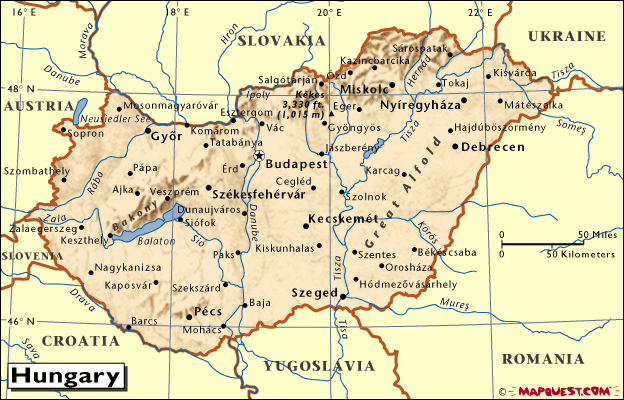Facts about Hungary

 Hungary is located in Central Europe. Hungary is oval in shape with a length from east to west of about 528 km and a maximum width from north to south of about 267 km. The capital and largest city is Budapest.
Hungary is located in Central Europe. Hungary is oval in shape with a length from east to west of about 528 km and a maximum width from north to south of about 267 km. The capital and largest city is Budapest.
 Hungary is predominantly flat. The River Danube divides it into two general regions.
Hungary is predominantly flat. The River Danube divides it into two general regions.
One of them is a low plain known as the Great Hungarian Plain (Great Alföld). Highlands along the northern border of the country extend eastward. Mount Kékes in the Mátra Mountains ( it is part of the highlands), is the highest peak in Hungary.
The area west of the Danube is known as Transdanubia, presents a variety of land forms. In the south rise the isolated Mecsek Mountains. In the north are the Bakony Mountains, which overlook Lake Balaton, the largest freshwater lake in central Europe. The north-western section of Hungary is another plainland the Little Alföld or Kisalföld.
Climate
Hungary has a moderately continental climate, with cold winters and warm summers. Average temperatures range from -1.1° C in January to 21.1° C in July. Rainfall is heaviest in early summer, and the average amount decreases from 787 mm along the western frontier to 508 mm in the east.
Natural Resources
The main natural resource of Hungary is the black soil of its farmlands. The alluvial soils of the Great Hungarian Plain are highly fertile. Soils in the northern highland river basins are generally fertile, but in much of Hungary the soil is of a loose type, called loess. The main mineral resources are: bauxite, coal, oil, natural gas, manganese, uranium, lignite, and iron ore.
Economy
Hungary has made the transition from a centrally planned to a market economy, with a per capita income one-half that of the Big Four European nations. Hungary continues to demonstrate strong economic growth and acceded to the European Union in May 2004. The private sector accounts for over 80% of GDP. Foreign ownership of and investment in Hungarian firms are widespread, with cumulative foreign direct investment totaling more than $23 billion since 1989. Hungarian sovereign debt was upgraded in 2000 and together with the Czech Republic holds the highest rating among the Central European transition economies; however, ratings agencies have expressed concerns over Hungary's unsustainable budget and current account deficits. Inflation has declined from 14% in 1998 to 7% in 2004. Unemployment has persisted around the 6% level, but Hungary's labor force participation rate of 57% is one of the lowest in the OECD. Germany is by far Hungary's largest economic partner. Policy challenges include cutting the public sector deficit to 3% of GDP by 2008, from about 5% in 2004, and orchestrating an orderly interest rate reduction without sparking capital outflows
Here's some data about our economy
Plants and Animals
 Approximately 18 per cent of Hungary is forested, mostly with oak, lime, beech, and other deciduous trees in the Transdanubian lands and mountains. Hungary also has plains, marshes, pastures, and meadows where plants and animals can live almost untouched, therefore it is rich in natural heritage. Hare, fox, deer, and boar are abundant. Duck, heron, crane, and stork are indigenous to the country, and the Great Hungarian Plain, which is mostly steppe, is a haven for many migrating species.
Approximately 18 per cent of Hungary is forested, mostly with oak, lime, beech, and other deciduous trees in the Transdanubian lands and mountains. Hungary also has plains, marshes, pastures, and meadows where plants and animals can live almost untouched, therefore it is rich in natural heritage. Hare, fox, deer, and boar are abundant. Duck, heron, crane, and stork are indigenous to the country, and the Great Hungarian Plain, which is mostly steppe, is a haven for many migrating species.
Some links
http://hipcat.hungary.org/intro.htm
http://hipcat.hungary.org/nobel.htm
http://hipcat.hungary.org/famous2.htm


 Hungary is located in Central Europe. Hungary is oval in shape with a length from east to west of about 528 km and a maximum width from north to south of about 267 km. The capital and largest city is Budapest.
Hungary is located in Central Europe. Hungary is oval in shape with a length from east to west of about 528 km and a maximum width from north to south of about 267 km. The capital and largest city is Budapest. Hungary is predominantly flat. The River Danube divides it into two general regions.
Hungary is predominantly flat. The River Danube divides it into two general regions. Approximately 18 per cent of Hungary is forested, mostly with oak, lime, beech, and other deciduous trees in the Transdanubian lands and mountains. Hungary also has plains, marshes, pastures, and meadows where plants and animals can live almost untouched, therefore it is rich in natural heritage. Hare, fox, deer, and boar are abundant. Duck, heron, crane, and stork are indigenous to the country, and the Great Hungarian Plain, which is mostly steppe, is a haven for many migrating species.
Approximately 18 per cent of Hungary is forested, mostly with oak, lime, beech, and other deciduous trees in the Transdanubian lands and mountains. Hungary also has plains, marshes, pastures, and meadows where plants and animals can live almost untouched, therefore it is rich in natural heritage. Hare, fox, deer, and boar are abundant. Duck, heron, crane, and stork are indigenous to the country, and the Great Hungarian Plain, which is mostly steppe, is a haven for many migrating species.